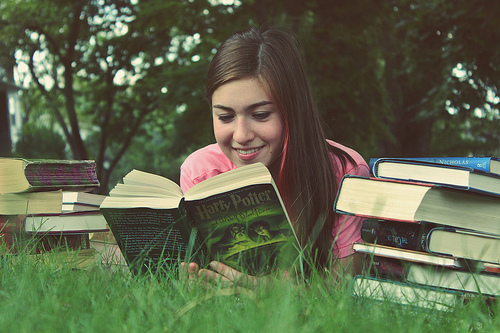 One of the teens profiled in my first book, “That Crumpled Paper Was Due Last Week,” did not enjoy reading when he first visited our Green Ivy office. He had been recently diagnosed with ADHD, and was incredibly annoyed at the prospect of having to read Jane Austen’s “Pride and Prejudice” as his required school summer reading. Finally, I sat down with him one afternoon and we read the first several chapters of the book together. I highlighted the novel’s underlying humor and the wit, and he quickly caught on. By the following week, he was hooked (and had even read ahead) – which shocked me, honestly. He actually finished reading “Pride & Prejudice,” and ended up reading another one of Jane Austen’s books later on. Seriously.
One of the teens profiled in my first book, “That Crumpled Paper Was Due Last Week,” did not enjoy reading when he first visited our Green Ivy office. He had been recently diagnosed with ADHD, and was incredibly annoyed at the prospect of having to read Jane Austen’s “Pride and Prejudice” as his required school summer reading. Finally, I sat down with him one afternoon and we read the first several chapters of the book together. I highlighted the novel’s underlying humor and the wit, and he quickly caught on. By the following week, he was hooked (and had even read ahead) – which shocked me, honestly. He actually finished reading “Pride & Prejudice,” and ended up reading another one of Jane Austen’s books later on. Seriously.
So, what’s the likelihood of getting a teen boy in today’s world who doesn’t read for fun to get into Jane Austen’s “Pride and Prejudice”? Most people would say the odds would be somewhere between slim and none. And yet, this reading experience totally transformed his way of thinking, and also helped him gain confidence in his abilities as a student. He finally participate in classroom discussions and offered opinions where there once were none.
As quaint as it sounds, reading “Pride and Prejudice” was really this young man’s first step in transforming his academic career.
That was just one of the reasons I read Commonsense Media’s latest report with trepidation. Their latest report that studied national data and found that reading rates have dropped among adolescents, with 53% of 9-year-olds and 17% of 17-year-olds classifying themselves as daily readers. What’s more, the proportion who “never” or “hardly ever” read tripled since 1984. A third of 13-year-olds and 45% of 17-year-olds say they’ve read for pleasure one to two times a year, if that. The report discusses how reading achievement among older teens remains stagnant, and there girls are more likely to read and be more proficient in reading then boys (which makes sense, because the more you read, the more proficient you become). Most troubling to me, given the achievement gap in America, is the gap in reading scores between white, black, and Latino children.
Frank Bruni wrote a great piece in the NYTimes entitled “Read, Kids, Read” all about what he finds to be one of the great equalizers of American opportunity – every study shows that those who read more typically fare better in school, life, and overall happiness. Basically, reading is the antidote to everything. So why are our kids not reading more, and what can we do to change that?
As someone who has successfully managed to get many teens to read for fun (and like doing it!), I can offer some tips. As with anything, it’s all about the approach. If you go into these tips thinking they won’t work, they won’t. You know your children or students better than anyone, so pick and choose and adjust as needed. Remember: reading is free, and the results are priceless.
Switch out the screen for a physical book. I see you waiting in the doctor’s office, or at the restaurant, wanting a few moments of silence. You hand your young children an iPad/phone/other device and they become intensely fixated on a game within seconds. I get it – silence is so precious sometimes, no judgment here. But why not occasionally pull out a new (or new to you) book like it is a treat rather than go right for the screen? Your kid might surprise you.
Carve out reading opportunities. One of the issues often noted by parents is that their children have too much homework, or too many other activities, to have time to read. But reading should really be thought of as meditative and relaxing. Set a timer for 25 minutes a day of reading time – most pre-teens and teens are on some form of gaming social media or gaming for at least 25 minutes a day, so it’s not a huge shift in time. It becomes an even easier shift if parents take the time to sit down and read as well. Like anything, if you don’t make time for it, it won’t happen. And eventually, your child will get so into a book they won’t want to stop. Trust me.
Shop for books regularly. As a writer, I admit bookstores and stationary stores are a personal weakness. Shopping doesn’t necessarily mean purchasing (though as an author, I love when people buy books!). Libraries are great, city-funded establishments, and books are FREE there. Make it a habit to go once a week, or once every other week. With younger kids it can be a half-hour excursion. With older kids, use it as a chance to get homework done on the weekends for a few hours, and swap out some books.
Leave books out for kids to peruse. In our office, we leave a few different books in the waiting room, as well having a well-stocked bookshelf. Sometimes when students arrive early, or are waiting for a parent to pick them up, they will pick up a book and just get enthralled. Then, they will either pick it up next time and continue reading, or sometimes, ask to borrow it because they want to finish it. If the books aren’t there, the kids never have the opportunity to pick them up.
Read an article or book as a family – and rotate who chooses. As your children get older, having everyone read a certain magazine or newspaper article (anywhere from 800-1500 words) and have everyone discuss is probably one of the best ways to break the awkward silence of dealing with a surly or emotional teenager. If you can all read a book together, terrific. For those who like sports, I like Darcy Frey’s The Last Shot. Those interested in historical fiction might like Tim O’Brien’s The Things They Carried about the Vietnam War. And it might spur on conversations in an organic, unobtrusive way.
Rotate in real books for e-books. There are studies now suggesting that writing things down helps with retention – this does not surprise me given what I’ve seen in my office. E-books are great from a portability standpoint (and I certainly read my share) but I vastly prefer the actual book to write in, underline, and mark up. Personal preference. As with everything, switch it up, practice moderation, and find what works best for you and your children.
Audio is a wonderful (and incredibly viable) option. Over the years, I have worked with many students with different diagnosed learning disabilities, including dyslexia. For some students, listening to books aloud can be a much better option. A learning specialist once remarked to me how for centuries we communicated things orally, and it was just with the advent of the printing press that written books became such a mainstay. I like to say, “It doesn’t really matter how a student best process’ information, rather, the student needs to learn how they learn best and utilize the tools to take advantage of their learning style.” Some students go along in the book as they listen, and others choose to simply listen to the book. With the newest technology, audiobooks are even easier than ever before.
Summer is upon us soon, and we’ve got a window of opportunity to promote reading to our youngest generations. Reading for pleasure allows us the opportunity to reflect, to self-soothe, and escape any worries or troubles for a time.
So readers, what was the last book you read for fun?

